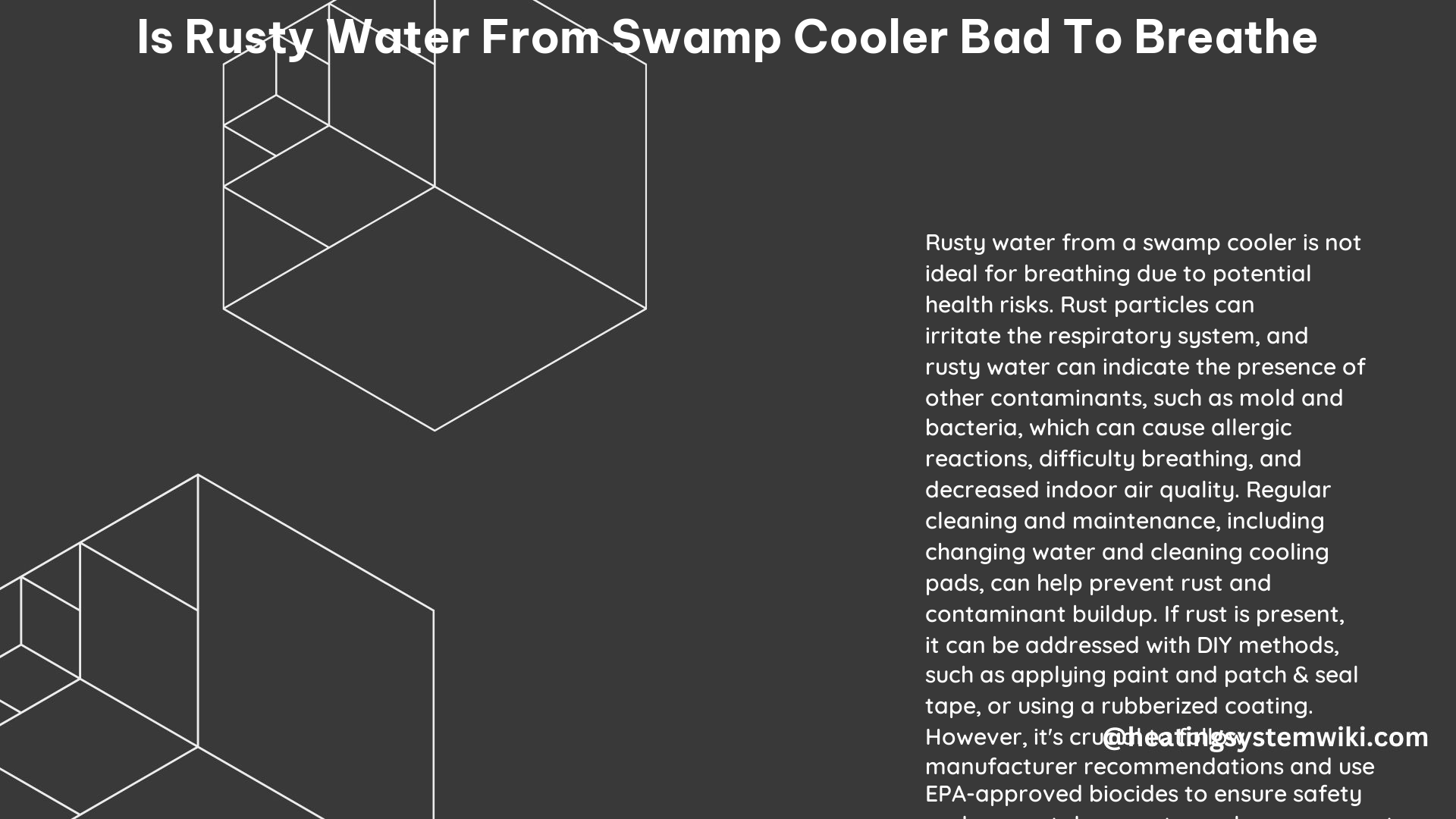Rusty water from a swamp cooler may not be directly hazardous to breathe, but it can indirectly lead to potential health issues by indicating the presence of other contaminants, such as mold, mildew, or bacteria, which can negatively affect indoor air quality and potentially cause respiratory problems.
Understanding Swamp Coolers and Rust
Swamp coolers, also known as evaporative coolers, work by pushing hot air through water-soaked pads, reducing the air temperature through evaporation. They are particularly effective in desert climates where humidity is low. However, if not properly maintained, these cooling systems can become breeding grounds for various contaminants.
The presence of rust in a swamp cooler’s water is a common issue that can arise due to several factors:
- Aging Components: Over time, the metal components of a swamp cooler, such as the water pan, can start to corrode and develop rust, especially in areas with high mineral content in the water.
- Water Quality: The quality of the water used in the swamp cooler can also contribute to rust formation. Water with high levels of dissolved minerals, such as iron or calcium, can accelerate the rusting process.
- Improper Maintenance: Neglecting regular cleaning and maintenance of the swamp cooler can allow rust to accumulate, as well as promote the growth of mold, mildew, and bacteria.
Is Rusty Water Hazardous to Breathe?

The rust itself found in swamp cooler water is not considered directly toxic or hazardous to breathe. Rust is primarily composed of iron oxide, which is not a known respiratory irritant or toxin. However, the presence of rust can be an indicator of other potential contaminants that may be present in the water or the cooler itself.
Potential Health Concerns
While the rust itself is not a direct health concern, the following issues can arise from a swamp cooler with rusty water:
- Mold and Mildew Growth: Stagnant water and poor maintenance can lead to the growth of mold and mildew, which can release spores into the air and cause respiratory problems, especially for individuals with allergies or asthma.
- Bacterial Contamination: Warm, stagnant water in a swamp cooler can become a breeding ground for various bacteria, such as Legionella, which can cause Legionnaires’ disease, a severe form of pneumonia.
- Mineral Buildup: Minerals in the water, such as calcium and magnesium, can accumulate in the cooler, leading to the formation of scale and potentially affecting the efficiency of the cooling system.
Maintaining a Swamp Cooler to Prevent Rust and Contaminants
To address rust and potential contaminants in a swamp cooler, it is essential to follow a regular maintenance routine:
Cleaning the Cooler
- Start by thoroughly cleaning the cooler, removing any peeling paint and rust. Use a pressure washer or high-pressure hose nozzle to dislodge debris, followed by a hand scraper, oscillating multitool, sandpaper, or wire brush for tough spots.
- Ensure that all surfaces, including the water pan, are thoroughly cleaned and free of any buildup or contaminants.
- Consider using a mild, non-toxic cleaning solution specifically designed for evaporative coolers to help remove stubborn deposits and disinfect the system.
Applying Protective Coatings
- Use a quality interior/exterior spray paint to touch up any rusty spots inside the cooler, focusing on corners and areas near the water line.
- For the exterior, apply a color-matched exterior paint or choose a new color, giving each panel several light coats.
- Apply Gorilla 4-inch by 10-foot white Patch & Seal Tape to a clean, dry pan, ensuring it extends past the water line. Press down firmly, especially at overlaps, and fill any gaps with patches.
- Consider using a coating specifically designed for evaporative coolers, or opt for a non-toxic rubberized coating like Flex Seal, which conforms to the pan’s curves and provides additional protection.
Regular Maintenance and Cleaning
- Clean the swamp cooler every three to four weeks during the cooling season to prevent stagnation, bad odors, and mold growth.
- Replace the water in the cooler regularly, and avoid letting the water sit for extended periods.
- Inspect the cooler for any signs of rust, mold, or other contaminants, and address them promptly.
- Consider using a water treatment system or adding a water purifier to the cooler to improve the quality of the water and reduce mineral buildup.
By following these maintenance steps, you can help ensure that your swamp cooler continues to provide cool, clean air without negatively impacting indoor air quality or posing potential health risks.
Conclusion
While rusty water from a swamp cooler is not directly hazardous to breathe, it can be an indicator of other potential contaminants that may be present in the system. By maintaining your swamp cooler regularly, addressing any rust or buildup, and ensuring proper water quality, you can help create a safer and more efficient cooling environment for your home.
